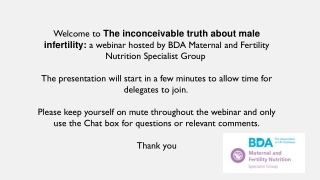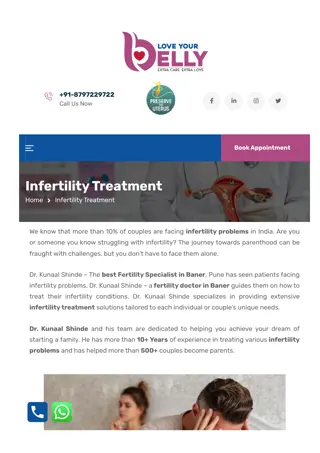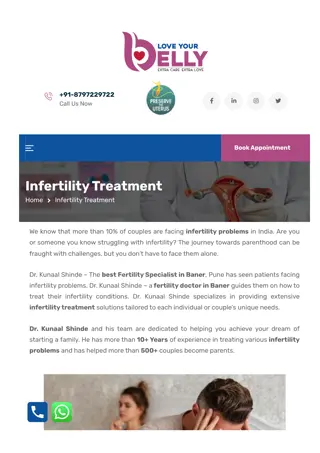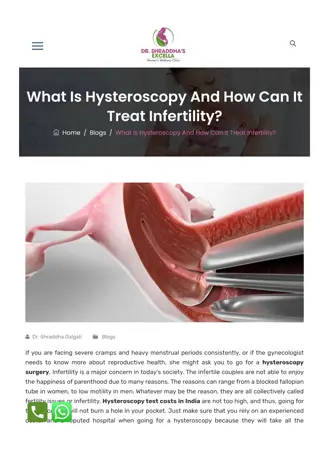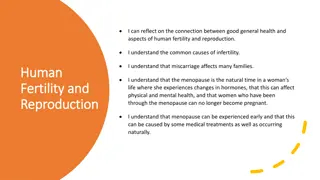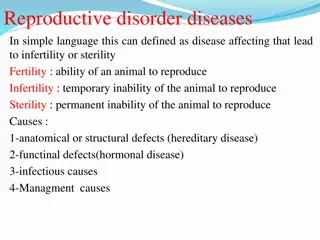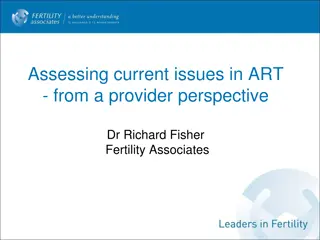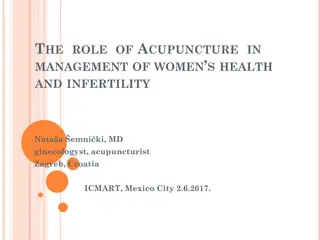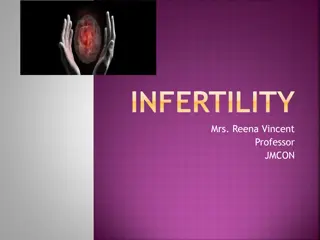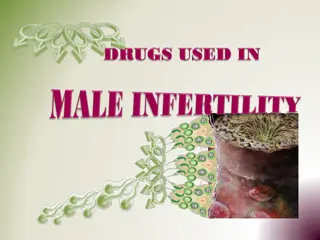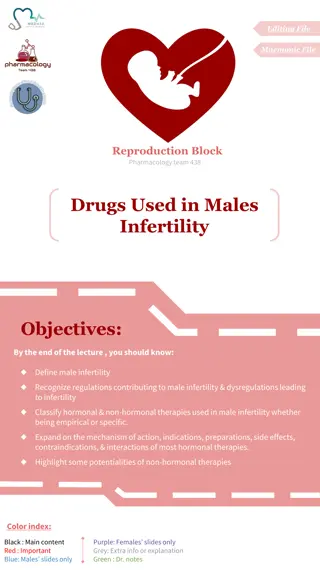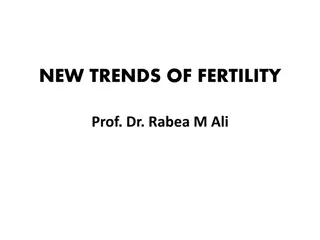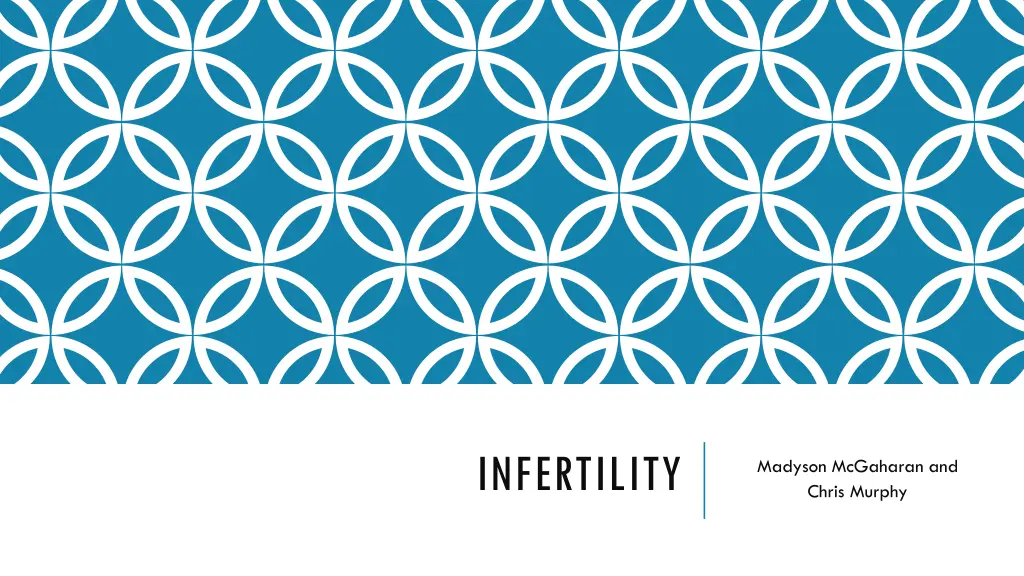
Understanding Female Infertility: Causes, Diagnosis, and Impact
Learn about female infertility, including its definition, prevalence, causes such as fallopian tube damage and hormonal issues, how age affects fertility, and methods to determine underlying causes such as blood tests and hysterosalpingography. Infertility can impact both women and men, with various factors contributing to difficulties in conceiving.
Download Presentation

Please find below an Image/Link to download the presentation.
The content on the website is provided AS IS for your information and personal use only. It may not be sold, licensed, or shared on other websites without obtaining consent from the author. If you encounter any issues during the download, it is possible that the publisher has removed the file from their server.
You are allowed to download the files provided on this website for personal or commercial use, subject to the condition that they are used lawfully. All files are the property of their respective owners.
The content on the website is provided AS IS for your information and personal use only. It may not be sold, licensed, or shared on other websites without obtaining consent from the author.
E N D
Presentation Transcript
INFERTILITY Madyson McGaharan and Chris Murphy
WHAT IS INFERTILITY? Infertility by definition is the inability to reproduce after one year of unprotected sex.
HOW MANY PEOPLE ARE AFFECTED BY INFERTILITY? Approximately 10% of American citizens suffer from infertility. According to studies, 1/3 of the diagnosis of infertility in the couple is due to female infertility, 1/3 is due to male infertility, and the remaining 1/3 are due to infertility in both partners. In 20% of all infertility cases, the cause is unknown.
HOW CAN AGE AFFECT INFERTILITY IN FEMALES o Women are born with a finite amount of eggs, meaning the eggs (oocytes) cannot be reproduced by the female. oWhile getting older, the quantity and quality of eggs diminish. oAfter the age of 30, the chances of having a baby decrease by 3%-5% each year
WHAT ARE THE CAUSES OF FEMALE INFERTILITY? Damage to Fallopian Tubes Damage to the Fallopian Tubes, which carry eggs from the ovaries to the uterus, can prevent contact between egg and sperm. Pelvic infections, endometriosis, and pelvic surgeries create scar tissue that may damage the oviducts (Fallopian Tubes) Hormonal Causes Some women have problems with ovulation. Synchronized hormonal changes leading to the release of an egg from the ovary and the thickening of the endometrium (lining of the uterus) in preparation for the fertilized egg do not occur. These problems may be detected using basal body temperature charts, ovulation predictor kits, and blood tests to detect hormone levels. Cervical Causes A small group of women may have a condition in which the sperm cannot pass through the cervical canal, whether due to an abnormal production of mucus or a prior cervical surgery. May be treated with intrauterine insemination. Uterine Causes Abnormal anatomy of uterus, presence of polyps and fibroids. Unknown Causes Approximately 20% of all cases causes cannot be determined
HOW CAN THE CAUSES OF FEMALE INFERTILITY BE DETERMINED? A blood test to check hormone levels An endometrial biopsy to test the lining of uterus To find scar tissue and tubal obstruction, hysterosalpingography and laparoscopy tests may be ran Hysterosalpingography: Involves X-Ray or ultrasound of reproductive organs. Either dye or saline are injected into the cervix and travel through the oviducts. This allows doctors to see if oviducts are damaged or blocked Laparoscopy: A slender tube fitted with a fiberoptic camera (laparoscope) is inserted into the abdomen via an incision near the bellybutton to allow doctors to see inside of the female reproductive system.
HOW CAN FEMALE INFERTILITY BE TREATED? oLaparoscopy Women who have been diagnosed with tubal or pelvic disease can either undergo surgery to reconstruct the reproductive organs or try to conceive through in vitro fertilization (IVF). Using a laparoscope inserted through a cut near the belly button, scar tissue can be removed, endometriosis treated, ovarian cysts removed, and blocked tubes opened. oHysteroscopy A hysteroscope placed into the uterus through the cervix can be used to remove polyps and fibroid tumors , divide scar tissue, and open blocked tubes oMedical Therapy Women may be prescribed drugs to promote ovulation, some even promote the release of multiple eggs per cycle
TREATMENT CONTINUED Intrauterine Insemination Intrauterine insemination refers to an office procedure in which semen is collected, rinsed with a special solution, and then placed into the uterus at the time of ovulation. The sperm are deposited into the uterus through a slender plastic catheter that is inserted through the cervix In Vitro Fertilization IVF refers to a procedure in which eggs are fertilized in a culture dish and placed into the uterus. The woman takes gonadotropins to stimulate multiple egg development. When monitoring indicates that the eggs are mature, they are collected using a vaginal ultrasound probe with a needle guide ICSI (Intracytoplasmic Sperm Injection) Used when there is a sperm-related infertility. GIFT (Gamete Intrafallopian Tube Transfer) Egg Donation
HOW CAN AGE AFFECT INFERTILITY IN MALES? Sperm quality in males generally decrease with age, so it will be harder for an older men to get his partner pregnant, although it is still possible.
WHAT ARE THE CAUSES OF MALE INFERTILITY? Varicocele- Swelling of veins that drain the testicles Infections- some infections can interfere with sperm production or health, including some STDs and inflammations. Retrograde Ejaculations- when sperm goes to bladder during ejaculation instead out of the tip of the penis. Heavy exposure to: industrial chemicals, radiation, or x-rays. Overheating of the testicles- Can reduce sperm reduction slightly
CAUSES CONTINUED Use of illegal drugs and alcohol- Reduction of sperm count, quality, and production, and lower testosterone levels Stress and Weight- Can affect hormones that are needed for sperm production Prolonged Bicycling- Seat can cause excessive heat to testicles Erectile Dysfunction- Inability to get and/or keep and errection long enough for intercourse
HOW CAN THE CAUSES OF MALE INFERTILITY BE DETERMINED? Semen Analysis- Ejaculating into a special container that is then sent to a laboratory to get tested. Scrotal Ultrasound Transrectal Ultrasound- Wand that is inserted into rectum to check prostate and see if there are any complications. Testicular Biopsy- Removing sperm samples with a needle to check if sperm production is normal Blood tests to check hormone production
HOW CAN MALE INFERTILITY BE TREATED? Surgery to repair abnormalities or damaged reproductive organs. Also effective in blockage removals. Medicines can assist in hormone imbalances and erectile dysfunction.
WORKS CITED 1. http://yourfertility.org.au/for-women/age 2. http://www.mayoclinic.org/diseases-conditions/male- infertility/basics/causes/con-20033113 3. http://www.mayoclinic.org/diseases-conditions/male-infertility/basics/tests- diagnosis/con-20033113 4. https://www.nichd.nih.gov/health/topics/menshealth/conditioninfo/Pages/treatm ents.aspx

